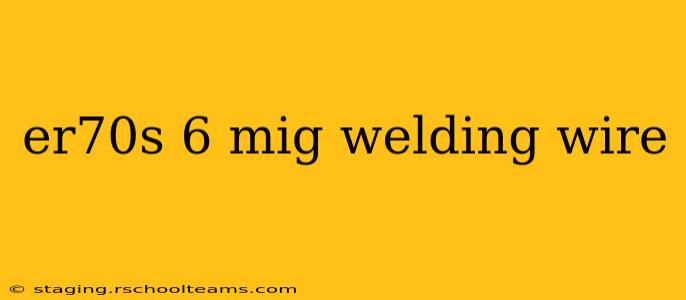ER70S-6 MIG welding wire is a popular choice for many welding applications due to its versatility and excellent mechanical properties. This comprehensive guide will delve into its characteristics, applications, and considerations for optimal performance. We'll answer common questions and provide insights to help you make informed decisions when choosing your welding consumables.
What is ER70S-6 Welding Wire?
ER70S-6 is a solid wire, meaning it doesn't contain a flux core, commonly used in gas metal arc welding (GMAW), more commonly known as MIG welding. The "ER" designates it as an electrode for arc welding, "70" indicates its tensile strength (70,000 psi minimum), "S" signifies it's a solid wire, and "6" specifies its specific chemical composition and mechanical properties optimized for a balance of strength and weldability. This wire is known for its smooth arc characteristics, excellent spatter control, and good weld bead appearance.
What are the Applications of ER70S-6?
ER70S-6's versatility makes it suitable for a wide range of applications, including:
- Automotive Repair and Fabrication: Its strength and weldability make it ideal for repairing and building automotive components.
- General Fabrication: Common uses include welding sheet metal, tubing, and other mild steel components in various industries.
- Construction: Utilized in the fabrication of structural steel elements in buildings and other constructions.
- Manufacturing: Used extensively in the production of various steel products.
What are the Advantages of Using ER70S-6?
Several advantages contribute to the popularity of ER70S-6:
- High Strength: The "70" designation indicates its high tensile strength, resulting in strong and durable welds.
- Good Weldability: It offers excellent arc characteristics, producing smooth welds with minimal spatter.
- Versatility: Suitable for a wide range of applications and thicknesses.
- Cost-Effective: It's a relatively inexpensive option compared to some other welding wires.
What Type of Gas is Used with ER70S-6?
ER70S-6 typically utilizes a shielding gas mixture, most commonly 75% argon and 25% carbon dioxide (Ar/CO2). This blend provides excellent arc stability and penetration. Pure CO2 can also be used, but it typically results in more spatter and a less aesthetically pleasing weld bead. The choice of gas often depends on specific application requirements and welder preference.
What are the Differences Between ER70S-2 and ER70S-6?
While both are solid wires for MIG welding mild steel, ER70S-6 offers slightly improved mechanical properties and weldability compared to ER70S-2. The subtle differences in chemical composition result in a slightly stronger and more consistent weld. The choice between the two often depends on the specific application and desired weld properties.
What is the Tensile Strength of ER70S-6?
ER70S-6 welding wire has a minimum tensile strength of 70,000 psi (pounds per square inch). This high tensile strength translates to strong and durable welds capable of withstanding significant stress.
How Do I Choose the Right ER70S-6 Wire Diameter?
The diameter of the ER70S-6 wire you choose depends on the thickness of the metal being welded and the desired welding speed and penetration. Thinner wires are better suited for thinner materials, while thicker wires are necessary for thicker materials. Always consult the manufacturer's recommendations for optimal wire diameter selection.
Conclusion
ER70S-6 MIG welding wire remains a highly versatile and reliable choice for numerous applications. Its combination of strength, weldability, and cost-effectiveness makes it a staple in many workshops and industrial settings. By understanding its properties and applications, you can ensure optimal performance and achieve high-quality welds consistently. Remember to always follow safety precautions and consult relevant manufacturer guidelines when using welding equipment and consumables.
